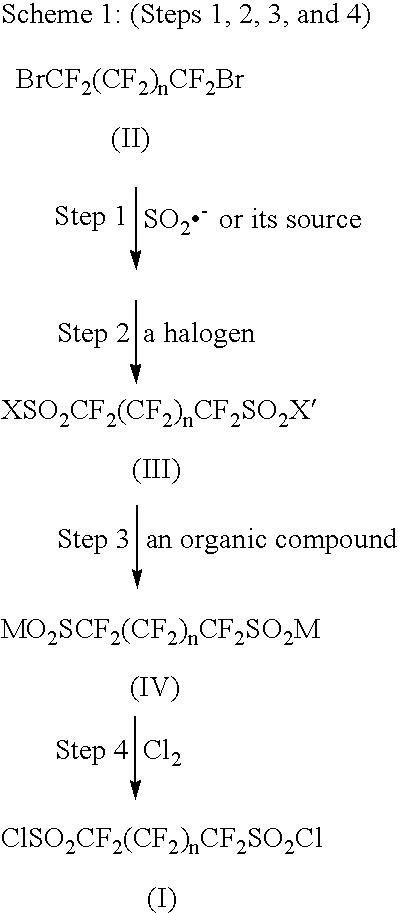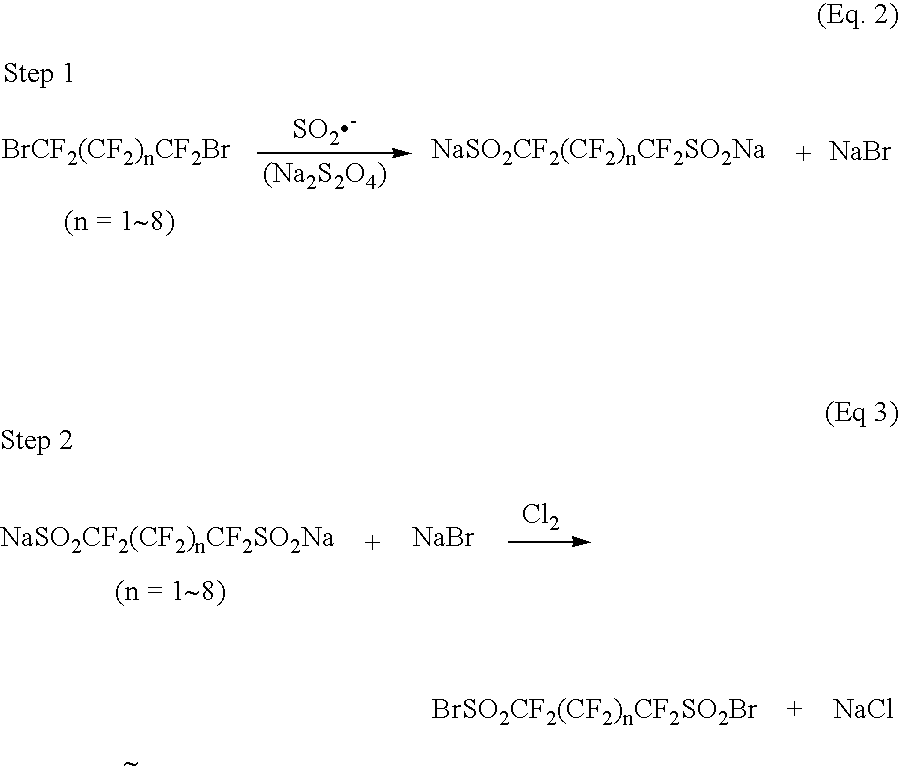Methods for producing perfluoroalkanedi(sulfonyl chloride)
a technology of perfluoroalkanedi and sulfonyl chloride, which is applied in the field of methods for producing perfluoroalkanedi(sulfonyl chloride), can solve the problems of low production efficiency and yield, enhanced costs, and further reduced yields
- Summary
- Abstract
- Description
- Claims
- Application Information
AI Technical Summary
Benefits of technology
Problems solved by technology
Method used
Image
Examples
example 1
Synthesis of perfluoropropane-1,3-di(sulfonyl-chloride) from 1,3-dibromoperfluoropropane
[0068]
Step 1: Synthesis of sodium perfluoropropane-1,3-di(sulfinate) and NaBr
[0069]A 2 L three-necked round bottom flask equipped with a magnetic stirrer, a dropping funnel, and a condenser was charged with 188 g (1.08 mol, assay ca. 85%) sodium dithionite (sodium hydrosulfite) Na2S2O4) and 121 g (1.44 mol) of sodium hydrogencarbonate. Nitrogen gas was flowed to remove air in the flask. Water (600 mL) and then acetonitrile (400 mL) were added to the mixture and the reaction mixture was warmed to 35° C. After the nitrogen flow was stopped, 124 g (0.400 mol) of 1,3-dibromoperfluoropropane (Exfluor Research Corp.) was dropwise added into the stirred reaction mixture for 2 hours. During dropping, gas evolution from the reaction mixture was observed. After dropping, the reaction mixture was kept at 35° C. for 0.5 hours and then heated to 50° C. After keeping the reaction at 50° C. for 1 hour, the reac...
example 2
Synthesis of perfluoropropane-1,3-di(sulfonyl chloride) from 1,3-dibromoperfluoropropane
Step 1: Synthesis of sodium perfluoropropane-1,3-di(sulfinate) and NaBr using Na2HPO4 instead of NaHCO3 used in Step 1 of Example 1
[0076]
[0077]A 500 mL three-necked round bottom flask was charged with 39.7 g (0.228 mol, assay ca. 85%) sodium dithionite (sodium hydrosulfite) and 32.4 g (0.228 mol) of sodium phosphate dibasic (Na2HPO4). Nitrogen gas was flowed to remove air in the flask, and 150 mL of water and then 100 mL of acetonitrile were added to the flask. The reaction mixture was heated to 35° C. Into the stirred mixture, 30 g (0.097 mol) of 1,3-dibromoperfluoropropane was added dropwise over 0.5 hour. After dropping, the reaction mixture was kept at 35° C. for 0.5 hour, and then heated to 50° C. The reaction mixture was kept at 50° C. for 0.5 hour, and then heated to 65° C. The mixture was continuously stirred at 65° C. overnight. The reaction mixture was then cooled to room temperature an...
example 3
Synthesis of perfluoropropane-1,3-di(sulfonyl bromide) from sodium perfluoropropane-1,3-di(sulfinate) with bromine
[0080]
[0081]A water layer containing perfluoropropane-1,3-di(sulfinate) was prepared from 1,3-dibromoperfluoropropane according to the procedure of Step 1 or Steps 1, 2, and 3 of Example 1. The water layer (122 g) containing 0.038 moles of sodium perfluoropropane-1,3-di(sulfinate), which was prepared by the procedure of Steps 1, 2, and 3, was charged into a three-necked round bottom flask equipped with a mechanical stirrer, a dropping funnel, and a gas inlet and outlet. Into the fask, 100 mL of dichloromethane was added. After the flask was purged with nitrogen gas, the reaction mixture was cooled in a bath of −5° C. Bromine was dropwise added to the stirred reaction mixture until a red color remained in the solution. The amount of bromine used was 6.5 mL (0.126 mol). The reaction mixture was kept at −5° C. for 20 minutes with stirring. The red reaction mixture was trans...
PUM
| Property | Measurement | Unit |
|---|---|---|
| aqueous | aaaaa | aaaaa |
| purity | aaaaa | aaaaa |
| potential life time | aaaaa | aaaaa |
Abstract
Description
Claims
Application Information
 Login to View More
Login to View More - R&D
- Intellectual Property
- Life Sciences
- Materials
- Tech Scout
- Unparalleled Data Quality
- Higher Quality Content
- 60% Fewer Hallucinations
Browse by: Latest US Patents, China's latest patents, Technical Efficacy Thesaurus, Application Domain, Technology Topic, Popular Technical Reports.
© 2025 PatSnap. All rights reserved.Legal|Privacy policy|Modern Slavery Act Transparency Statement|Sitemap|About US| Contact US: help@patsnap.com



